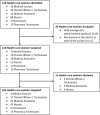Health care workers' knowledge on identification, management and treatment of snakebite cases in rural Malawi: A descriptive study
- PMID: 36409666
- PMCID: PMC9678285
- DOI: 10.1371/journal.pntd.0010841
Health care workers' knowledge on identification, management and treatment of snakebite cases in rural Malawi: A descriptive study
Abstract
Snakebite envenoming remains a public health threat in many African countries, including Malawi. However, there is a shortage of literature on the knowledge of Health Care Workers (HCWs) and the prevalence of snakebite cases in Malawi. We interviewed HCWs in Neno District to assess their knowledge of snake identification and management of snakebites. We further reviewed patient registers from 2018 to 2021 in all 15 health facilities in the district. We used descriptive statistics to characterize the survey population, knowledge, snake antivenom (SAV) administration, and snake identification. Using "shapefiles" from Open Street Maps, we mapped villages with snakebite cases. Of the 105 HCWs interviewed, 58% were males, and 60% had worked for less than five years. The majority (n = 93, 89%) reported that snakebite envenoming was a problem in the district. Among the clinicians, 42% said they had prescribed SAV previously, while among nurses, only 26% had ever administered SAV. There were discrepancies among clinicians regarding the dosing of snake antivenom. Significant gaps in knowledge also existed regarding snake identification. While two-thirds of HCWs could correctly name and identify venomous snake species, most (> 90%) failed for non-venomous snakes. Most (n = 100, 95%) reported that snakebite victims visit traditional healers more than the hospital. Between 2018 and 2021, the Neno District registered 185 snakebites with a yearly average of 36 cases per 100,000 population. Fifty-two percent (n = 97) were treated as an inpatient; of these cases, 72% were discharged in less than three days, and two died. More snakebite cases were recorded in the eastern part of the district. Significant knowledge gaps exist among HCWs in Neno regarding prescription and administration of SAV and snake identification, which likely challenges the quality of services offered to snakebite victims.
Copyright: © 2022 Aron et al. This is an open access article distributed under the terms of the Creative Commons Attribution License, which permits unrestricted use, distribution, and reproduction in any medium, provided the original author and source are credited.
Conflict of interest statement
The authors have declared that no competing interests exist.
Figures



References
-
- Kasturiratne A, Wickremasinghe AR, Silva N de, Gunawardena NK, Pathmeswaran A, Premaratna R, et al. The Global Burden of Snakebite: A Literature Analysis and Modelling Based on Regional Estimates of Envenoming and Deaths. PLOS Medicine. 2008;5: e218. doi: 10.1371/journal.pmed.0050218 - DOI - PMC - PubMed
Publication types
MeSH terms
Substances
Grants and funding
LinkOut - more resources
Full Text Sources

